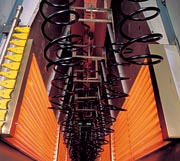Boost Coating Efficiencies with Infrared
An IR booster oven in combination with the traditional convection oven can create significant savings, and surprisingly excellent results. Benefits normally realized with total IR systems also can be realized with a booster add-on. There are several advantages to using an IR booster.
Less Time
The time parts spend in the curing process often is limited by the speed in which other operations occur in the entire finishing process, but if the oven ramp-up and dwell time is the limiting factor for your line speed, a booster oven can definitely provide help in speeding up production. IR energy, properly located and distributed, can ramp up temperatures much faster than hot air systems, while not necessarily having to evenly heat the product. An IR booster system in front of or just inside the convection oven vestibule will allow you to increase the speed because you can ramp up, gel or cure parts much faster.An IR booster after the convection oven also has proven to be a time saver in some instances. High temperature coatings sometimes achieve final cure with an IR boost after the convection oven, when IR is more suitable for building on an already heated/partially cured product, - and can do it more quickly vs. keeping the product in the hot-air oven.
If the time the product spends in the oven is a problem, then an IR booster should be a good solution, whether it is before, inside or after the convection oven.

Less Energy
If less time is spent in the oven, then obviously there can be energy savings involved. The benefit of less time in the oven will still need to be compared to the cost of the additional energy load installed in the booster system. The energy savings is normally realized by virtue of the decreased temperatures required in the convection oven. As an example, a 96 kW electric infrared booster system might result in the turn back of a 2,000,000 BTU convection oven by as much as 40 percent, translating into energy savings of: 1,200,000 BTUs (60 percent of 2,000,000) + 96 kW booster (328,000 BTUs) = 1,528,000 BTUs of energy consumed per hour. 1,528,000 BTUs/hr vs. 2,000,000 BTUs/hr = 23.6 percent overall energy savings. Paybacks with more than 20 percent or more energy savings can be extremely fast.
The advantages of IR energy enable these types of savings to occur. IR waves (rays) travel through space and can be impinged on the product (coating) directly, without the necessity of heating a volume of air, such as in a convection oven. The IR energy also can be accurately focused toward the product and very precisely controlled, realizing efficiencies not achievable with convection heat. All IR energy must be absorbed by the coating, reflected by the coating, or passed through the coating. IR wavelengths directly absorbed by the coating will contribute directly to the curing process. A major advantage with an IR booster system is that the reflected and transmitted IR can still contribute, because it remains in the oven and ultimately assists in the convection curing process, and reduces the amount of heat required from the burners.
Less Space
Space is at a premium at almost any facility. Stand-alone convection systems are very large in comparison to infrared ovens. The compactness of IR systems enables them to be located near the convection vestibule, or even inside the vestibule, by using emitters with ratings suitable for the substantial heat generated from the convection system. In one specific application, a manufacturer of heavy truck springs needed to convert one of its e-coat lines to powder, but it would have required two separate ovens on the production floor, and would have negatively impacted other production processes. The solution was to incorporate an electric IR booster inside the convection oven, thereby allowing for the gel and cure of the powder coated springs, as well as the complete cure for e-coated parts when run separately through the system. The company essentially added a curing system, realized increased production and reduced energy requirements; all without using any additional, valuable floor space.Less Capital Investment
The compactness and basic simplicity of IR booster systems normally will result in lower capital expenditures. IR boosters will cost much less than an additional convection oven, or usually less than adding to or retrofitting an existing oven. If the booster is located inside the convection oven, the major costs are limited to the emitters and a simple frame to mount the emitters, plus the control panel.Less Rework/Rejects
As mentioned previously, IR is directly impinged upon the product, so it does not require air or air movement to achieve heat transfer to the product. Even in the best-designed convection ovens, air movements can cause some contamination from airborne particles that can cause reason for rejection of the part. With an IR booster, the coating will experience little if any air movement if the booster is located before the convection oven, or even just inside the vestibule. There is less risk of contamination when the movement of air can be reduced or eliminated.Manufacturers of infrared finishing equipment have experience with design and application of IR as a boost to many existing hot-air systems. For many new installations, manufacturers and coaters now look to combine IR with hot-air convection systems because these "combination" systems are proving to be the most advantageous and economically attractive. A good resource for your specific application is the IRED (Infrared Equipment Division) of the IHEA (Industrial Heating Equipment Association); visit www. IHEA.org. Members have documented case studies for the application of IR booster systems, and all members have laboratory test facilities where the application can be tested for the best and most economical methods to achieve a quality finish. This testing is almost always done without cost to the end user.
Looking for a reprint of this article?
From high-res PDFs to custom plaques, order your copy today!



